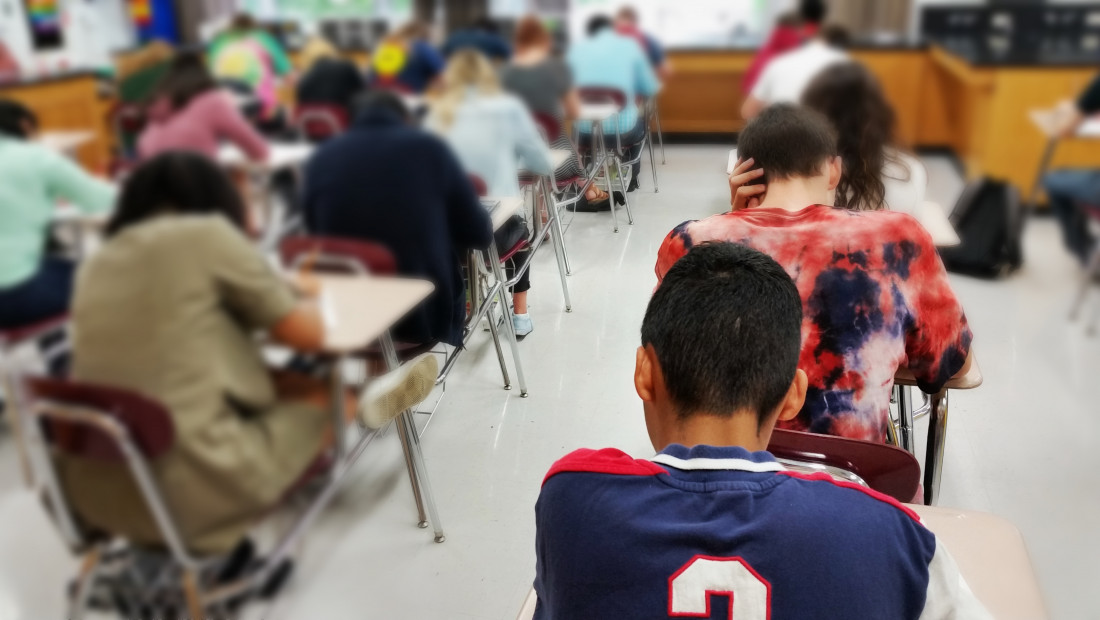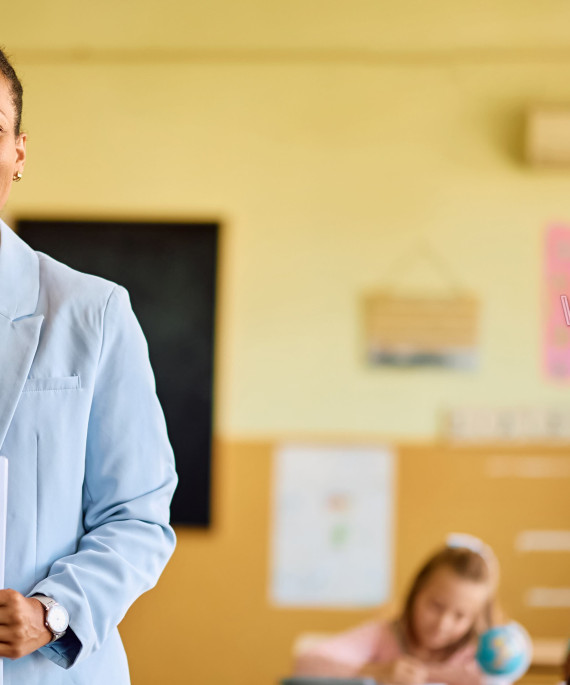Schooled in racial bias: Unraveling harm in K-12 education

Subscribe to Inspire
Apple Podcasts | Spotify | YouTube | Stitcher
Subscribe to the Inspire Podcast Newsletter
Transcript of Podcast
Robin Chenoweth: Summer Luckey was a master’s student when she got a window into a problem that some consider the greatest threat to American education.
Summer Lucky: I was at a high school and I was at that time just a practicum student
Robin Chenoweth: {Fighting sounds} There was a fight in the school where she was interning, between two high schoolers. One student was Black. As tempers escalated, that student removed an article of clothing, probably to keep it from ripping, Luckey says.
Summer Luckey: And she just like went for the girl. And afterwards, the administrators of that building, the one who I think might have been the lead principal, said things like, ‘Did you see her? What type of ghetto mess is that?’
Robin Chenoweth: It wasn’t the fight that shocked Luckey. It wasn’t the students’ heated language. What disturbed her most was the principal’s response.
Summer Luckey: I looked at him because I'm thinking like, surely you would catch yourself.
Summer Luckey: But why would you have to label her as ghetto, as a white male administrator, and then to your white female peers? I'm just curious now, what other interactions you've had with students that were primarily of color because the student body was very diverse. What other interactions have you had with them with that rhetoric?
Robin Chenoweth: Only teachers heard him use a term that by definition means low-class, cheap, inferior. The weight of his words, however, would fall squarely upon Black and brown students. This is the Inspire Podcast, a production of the College of Education and Human Ecology. I’m Robin Chenoweth. Carol Delgrosso is our audio engineer.
Robin Chenoweth: Racism in schools is not new. But a flood of research in the last 10 years has brought the problem into sharper focus. Students report being called racial slurs by classmates, being reprimanded when their white counterparts weren’t for congregating in halls or horseplaying, being harassed for wearing hijabs, being forced to read books that include the N- word.
Robin Chenoweth: Ohio State Professor Muhammad Khalifa studies educational administration and how schools can best combat racism through culturally responsive leadership.
Muhammad Khalifa: “We know from federal data that students of color are suspended three, four or five times more than all other students for the same exact offense, and particularly black men are suspended sometimes 15, 20 times more, especially if the particular offense that they're being suspended for is subjective.”
Robin Chenoweth: Students of color are much more likely to be called out, sent to the office and arrested in school. The problem spills into academics. Nationally, Black students are two times less likely than white students to earn advanced placement credit in science, and nearly three times less likely to earn credit in AP math.
Muhammad Khalifa: “If I'm African American boy and I go to advanced calculus class, the teacher has multiple ways of suggesting to me that I don't belong there. If I get an A on a test and they make a big deal out of it, that's a way of tokenizing me, it might be a way of exoticizing, making me seem that I'm not I don't belong there or that there's something strange and magical about me. There are also other ways in which teachers lower expectations on people who look different from them and who are students of color. So, all of these can be traced by various forms of data.”
Robin Chenoweth: And though education researchers know that a sense of belonging is a significant factor for academic success, one in three students in the United States say they feel like outsiders in their own schools.
Muhammad Khalifa: “It impacts the health, the longevity, the life chances, the very humanity of the students. So it's not like not understanding algebraic equations or not having a proper textbook that is age appropriate. It's not like any of those issues. None of those issues are going to stifle, literally take the life opportunities away from people like this issue will. So it's a very deep issue indeed.”
(Music)
Robin Chenoweth: Educators play an ongoing role in perpetuating racial inequity, often without realizing it. Former teacher and PhD student Christine Hines saw teachers de-escalate tense situations among white students, but then…
Christian Hines: “If a black kid starts standing up, and projecting their voice and getting angry, they're automatically on the school phone, calling the administrator, thinking a fight’s going to breakout. And I'm like, but you didn't do that for the other students. So why did you do that for this kid? And it's always that, well, um… Let's go ahead and say you did it because they were Black. And then I'm just like, you may want to check that or reassess that because that's harmful to the student. And you don't even realize it, because now they have a disciplinary action.”
Robin Chenoweth: How much do you think fear plays into it? Is that a big part of it?
Christian Hines: Oh, it's extremely a big part. It's a lot of what provokes the policing within the schools, because it's a different dynamic number one, when you're in the classroom, and you feel threatened. But even when they're in open spaces, like during hall changing times, during lunchtime. I would literally see teachers who got like hall duty or lunch duty, and they will be afraid to go. Or they stick to one side of the cafeteria, usually the white side. Or they see me or other teachers of color. It doesn't necessarily have to be a black teacher. They're like, “Oh, well, you see this group of kids over there? They’re being kind of loud. Can you go talk to them?” And my first thought in my mind is, “Why can't you talk to them?”
(Music)
Robin Chenoweth: Of course, nearly all educators go into the profession because they want to help kids. So how can schools deal with racism in a way that uplifts hurting students? Just like Summer Luckey discovered after the school fight she witnessed: Combating bias and discrimination begins with school leadership. It takes a shift from the top to institute any real change. Muhammad Khalifa drew the same conclusion while teaching in Detroit schools.
Muhammad Khalifa: I recognized quickly that if teachers don't have the proper support that, even though they might be equity oriented and they might be oriented to do social justice work in schools or in their classrooms. If they don't have the support they need, if they don't have the resources, if they are being pushed back, and being stifled, then they won't be able to really sustain the work in any engaged type of way.
Robin Chenoweth: He works with fellow scholars at the Culturally Responsive School Leadership Institute to do equity audits — intense explorations on where racial bias is occurring in schools. Then, they find ways to fix it.
Muhammad Khalifa: One of the reasons that is so bad in American schools is that educators by and large don't know how to address it or how to solve it. So I look at specific reasons that the equity data might be low for service to groups or for certain races or for certain language groups of students, not just if it's happening, and where it's happening, but why?
Robin Chenoweth: Once the gaps are identified, administrators are trained to fix them. Lesson No. 1? Don’t forget whom you’re serving. Looking at equity data alone misses the point.
Muhammad Khalifa: A lot of the models of equity audits out there do not engage student voice at all, they don't even get engaged parent experiences or voices at all. And then they go and make recommendations to a district based on just what teachers and leaders are saying. And that's exactly what my research pushes up against. So, for leaders to to act without collaboration deep collaboration with folks in the community and with students is a problem, and that's part of the problem why these equity problems are showing up the ways that they do, and are so sustained and are so stubborn.
Robin: Involving the community is time consuming. It’s difficult. It requires resources. And it’s absolutely necessary to pull schools out of the ruts they’ve been channeled into concerning race.
Khalifa: What our students coming to school with, what are the histories and experiences in the neighborhoods, and in their families that schools need to know about in order to best serve them
within the school? What are those experiences and those real life histories, both lived and ancestral histories and languages? What is it that school leaders need to know in order to be able to lead schools effectively — lead schools effectively? what do they need to know about the community and the students in order to lead schools, effectively. So these kind of questions have just not been asked by educators, up until very recently and even now is a very small number of educators who are even asking this question, and these types of questions.
Robin Chenoweth: A very compelling piece of the institute work that Khalifa does is giving students the opportunity to guide the process.
Muhammad Khalifa: We do something called youth participatory action research. It gives the power of students to investigate their own context, both school and community context, to decide what they want to study, to begin to collect that data and then to present that data in powerful ways to the district personnel who are now hearing and we have agreed that these students should be empowered. Because of course, these students already have the power it's just whether or not it will be recognized by people in schools.
(Music)
Robin Chenoweth: When Cynthia DeVese became the educational equity coordinator at Westerville City Schools seven years ago, the district had been hit with an unsettling report.
Cynthia DeVese: “There were a lot of disparities that basically mirrored what we're seeing nationally and statewide.
Robin Chenoweth: Disparities in disciplinary actions, in academic offerings to students of color, in how accepted some students felt in the school.
Cynthia DeVese: “So we knew that we needed to address it, then. And so that's when we began our work.”
Robin Chenoweth: DeVese — who is now also a doctoral student in the college — decided to get close up to the problems, studying them in the schools for a year. What the district needed, she decided, was to confront its systemic and implicit bias.
Cynthia DeVese: “We needed to have courageous conversations about our cultural mindset of our leaders. And so one of the things that we really wanted to do was start with our administrators and secondary leadership team, because we knew that in order for us to sustain the work for the long haul, we needed to get our leadership up to par In regards to how do we feel?
And what do we believe? And what do we need to move forward in order to be able to tackle some of the gaps that we saw?
Robin Chenoweth: The district worked with the Kirwan Institute, and then in 2020, with Ohio State’s College of Education and Human Ecology, to begin conversations with teachers and staff.
Cynthia DeVese: “So we really dug deep into what does implicit bias look like? How do prejudices reside in us? We looked at the brain and how it plays in our brain. And we looked at media with that, how these things are ingrained in us over a period of time.
Cynthia DeVese: We needed people to be aware that their decisions, right, could be impacted by something that they already have a bias to from outside sources, but then that plays on their decision-making capabilities in the classroom. And we need people to understand that clearly, so that they can be aware. So that when they need to make a decision, then they wouldn't be biased towards any students, but specifically those students who are marginalized.
Robin Chenoweth: Be the Change Professional Development Series for Educators was offered to thousands of teachers in Central Ohio, including Westerville Schools.
Robin Chenoweth: So I'm wondering if there was any piece that just kind of made them stop and go, Oh, that's me, or I did that.
Cynthia DeVese: In the module, there is a piece that was created specifically around the time of George Floyd. And it was giving students a voice, and they created student vignettes. And those student vignettes, were voice the voices of students in Central Ohio, who took to social media during the George flowing moment, to express their thoughts about the school system. We asked several students in our district if they can record their voice to these written vignettes. And so every person who went through the module had to hear the student's voice, about their story.
Their stories were about curriculum, their voice, their stories were about how they were treated by students,
Student 1: A Black friend of mine said he is so used to people calling him the N-word and asking for a pass that it doesn’t even affect him anymore, even though he is only a freshman. He told me he used to cry about it, and not understand, but now he just deals with it.”
Cynthia DeVese: how they were treated by teachers or educators in our district,
Student 2: “I get racist remarks almost daily and I have reported to school counselors, teachers and administrators multiple times just this last semester. And every single time they say they will look into it and give consequences. But nothing ever gets done.
Cynthia DeVese: Someone talked about how, as a student, they wanted support from a teacher because they felt alienated, right, because of who they were because of their race, or because of their gender, or because of their sexual orientation.
Student 3: I was burying my face in my sweater, trying not to cry.
Cynthia DeVese: And then they had to write a letter to the student addressing that. What would you do? How would you write a student who shared their voice today? What would you say? Those elements in that workshop, were just very powerful. Teachers walked away, saying it was heavy, but they needed to hear it, they needed to experience it, for them to begin to make change.
Robin Chenoweth: That gave me chill bumps when you said that you put the students voices to those quotes.
Robin Chenoweth: So is it changing your curriculum or your policies there at the schools?
Cynthia DeVese: It certainly has. This work has evolved over the seven years that I've been here. And we're seeing that what we have changed our policies, when it comes to our achievement, and getting our students into accelerated or advanced courses. When I first started here, there were prerequisites, you had to have a teacher recommend you for a course or you had to have a certain score. Now we in our secondary spaces that has been removed, and any student who wants to try or to be able to excel and to get into these spaces, they're open.
Robin Chenoweth: Books containing racial slurs have been put on pause, at the students’ request. Each school has an equity team with teachers, counselors, principals, parents and students. They make decisions together. Their efforts have begun to have an impact. And the data are bearing it out.
Cynthia DeVese: We have implemented different strategies and support systems, so that we're not at this space where Black and Brown students are three times more likely to be disciplined. So we're having conversations to make sure that our policies and our practices are equitable. And that's very important for us.
Robin Chenoweth: To learn more about the Be the Change Professional Development Series for Educators, created by Ohio State’s College of Education and Human Ecology, contact Nicole Luthy at luthy.22@osu.edu




